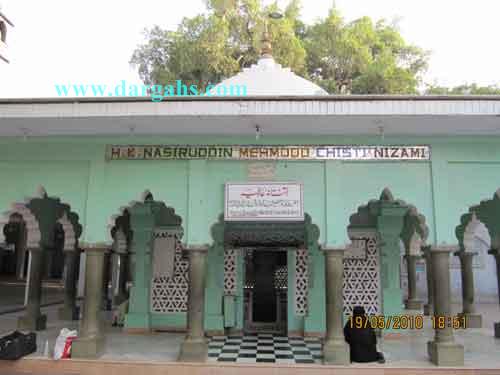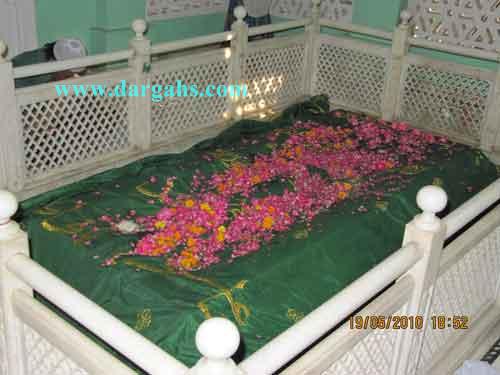Chiragh-e-Chisht
Hazrat Naseer-uddin Chiragh Dehlvi (rh)

The garden of love has blossomed beautifully; By its scent, my heart has become perfumed- That spot on my chest is like unto a flower! Salutations to you, look upon me now with eyes of mercy, O Naseer Uddin ! Do enlighten my lamp.
"You must stay in Dehli and suffer the persecution of the people." With these words, Hazrat Nizam Uddin Auliya r.a handed over the sacred relics of the Chishtiyyah silsilah to his successor, Khwaja Naseer Uddin Chiragh r.a. Thus did this great saint carry on the duties and uphold the blessed work of his illustrious predecessors under the most trying conditions and in the face of the greatest oppression. In his lifetime, Khwaja Naseer Uddin Chiragh r.a witnessed the final ruin of the kingdom of Delhi and the fragmentation of the Chishtiya silsilah. Under his guidance, the sacred order managed to stay true to its principles of remaining above politics and the whims of kings, even though in his haste to combat the popularity of the silsilah, the reigning sultan destroyed Delhi itself.

Khwaja Naseer Uddin Chiragh was born in Ayodha in India, the son of Sheikh Yahya Moahmud r.a and a descendant of Imam Hussain a.s. As with all the other great Chishti masters, he lost his father at an early age; and the responsibility for his education was devolved upon his mother. From a very young age he was fired with religious devotion, and was very particular about punctuality in congregational salah. Completing, he forsook worldly wealth at the age of 25 and wandered with a dervish throughout the wilderness of northern India for eight years. At the age of thrity-three, Khwaja Naseer Uddincame to Delhi and became a murid of Hazrat Khwaja Nizam Uddin Auliya r.a . It bears ample testimony to his universally recognized humility that when Hazrat Nizam Uddin Auliya r.a saw him at his khanqah and asked him what he wanted, he replied:" I have come to help the dervishes put on their shoes." The most reliable source of life history of Hafiz Muhammad Jamal is the book 'Jamalia' written by Maulvi Abdul Aziz Parharvi. As described in the book, Hafiz Muhammad Jamal was radiantly handsome, his teeth were unstrung pearls, his nose marvelously comely, his eyebrows thin, his chin pointed and his beard was extremely graceful. He used to walk at such a pace that young men were unable to keep up with him.
He had a ring, upon which were engraved the words "Allahu jamilun wa yohibbul jamal" (God is beautiful and loves beauty). His discourse used to be most sweet and agreeable. In his life there was no contradiction between preaching and practice. History testifies that very many Hindus also benefited from his teachings and he never acted in a discriminatory way towards them. It is undoubtedly true that after the great Bahauddin Zakariyya Multani it was the Suhrawardi order which flourished in the region.He was directed by his Peer-o-Murshid Hazrat Khwaja Nur MOhammed Maharvi r.a to establish the Khanqah in Multan, and get first person initiated into the Chishti order right on the Mazar of Hazrat BahaUddin Zakriya. From now Multan belongs to Chishtiya. Hafiz Jamal was the first saint to give currency to the Chishti order of sufism in Multan. He also established a very important centre of learning.
Hafiz Jamal died at the age of 66 on 5 Jamadi ul Sani 1226 ( 7th May, 1811). A chronogram for the date of his death was derived by his beloved pupil Munshi Ghulam Hassan from these words of Holy Quran: "innl muttaqin fi jannat". Two other chronograms in Persian verses are also inscribed over the eastern gate of the tomb. He married twice and one of his wife was from Laang family. He had a considerable number of spiritual successors such as Khwaja Khuda Bakhsh of Khairpur Tamiwali.
Hafiz Jamal was an excellent poet in Arabic, Persian and Siraiki. His "Seeharfi" is a poem in Siraiki which comprises 29 stanzas of four rhyming lines each, the fourth containing the poet's name 'Jamal'. In this Hafiz Jamal uses the spinning wheel and its appurtenances as symbols of deeds and character. Copy of this 'Seeharfi' is available in the Punjab University Library. It was also once published in Agra, India. Very many accounts of Hafiz Jamal and his sayings were composed, many of which exist in the earlier books. The best known are i) 'Fazail Raziyya', ii) 'Jamalia' , iii) 'Gulzar-e-Jamlia' written in 1325/1907, and iv)'Anwar-e-Jamlia'. Now many more books have been written.
The Mausoleum is situated near Aam Khas garden outside Daulat Gate, Multan. The tomb has been built within a wall resembling a fortification. The tomb lies on a platform





 This is a free homepage created with page4. Get your own on www.page4.com
This is a free homepage created with page4. Get your own on www.page4.com